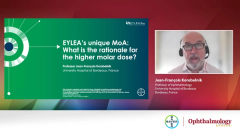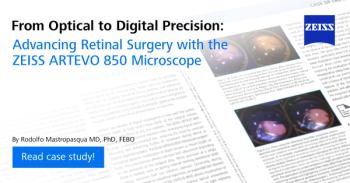
EYLEA 8mg in focus: Key learnings from the pivotal trials
Hello, and welcome to this video series sponsored by Bayer. I’m Professor Varun Chaudhary from McMaster University. In this video, we’ll focus on key insights from the pivotal trials for EYLEA 8 mg, specifically looking at the PULSAR and PHOTON studies.
Before we get started, I’d like to share my disclosures. I have been compensated by Bayer for my participation in this video.
Let’s first look at the study design for PULSAR and PHOTON. As you know, these were pivotal phase 3, global, double-masked, randomized control trials that evaluated the efficacy and safety of EYLEA [aflibercept] 8 mg in neovascular AMD [age-related macular degeneration], which was the PULSAR trial, and in diabetic macular edema [DME], which was the PHOTON trial.
In terms of study design itself, the PULSAR trial recruited treatment-naive patients with neovascular AMD, and these patients were randomly assigned 1:1:1 to EYLEA 2 mg given every 8 weeks, EYLEA 8 mg given every 12 weeks, or EYLEA 8 mg given every 16 weeks. Of note, all 3 arms got 3 monthly loading doses; that’s for neovascular AMD.
The PHOTON trial looked at diabetic macular edema. This had treatment-naive patients, as well as previously treated patients. Here, patients were randomly assigned to 3 different arms: EYLEA 2 mg, EYLEA 8 mg given every 12 weeks, and EYLEA 8 mg given every 16 weeks. The 2-mg patients were treated every 8 weeks after 5 monthly loading doses vs the 8-mg arms who only had 3 monthly doses before they were randomly assigned to every 12 or 16 weeks. The primary end point was mean change in BCVA [best-corrected visual acuity] looking at noninferiority compared with EYLEA 2 mg given every 8 weeks. The study end point is week 96, and there is an optional 1-year, open-label extension for the trials.
In terms of study methodology, it’s important to remember that very strict dose regimen modification criteria were used in the trial. What these criteria did was provide flexibility to allow patients to be treated more or less frequently, depending on how they were doing. In years 1 and 2, the dosing intervals could be shortened by 4 weeks at specific time points based on prespecified DRM [dose regimen modification] criteria, which were based on clinically relevant vision decrease and signal of disease activity. So in year 1, there were 4 opportunities to shorten the treatment interval in the 8-mg arm for patients who needed more frequent treatment. In year 2, stable patients with EYLEA 8 mg could be extended by 4 weeks at a time if they met prespecified DRM criteria. They had to have stability in vision and stable anatomy. It’s also important to note that the maximum interval for extension for 8 mg was up to every 24 weeks. That patient could be extended to up to every 24 weeks through week 96.
So how did the patients do? Well, both PULSAR and PHOTON trials demonstrated that EYLEA 8 mg resulted in sustained and meaningful vision gains with as few as 8 injections over 2-year period.
Let’s look at the individual trial study results. In PULSAR, which was the neovascular AMD trial, patients receiving EYLEA 8 mg at every 12 weeks and every 16 weeks achieved noninferiority in terms of vision gains. So the study met its primary end point at week 48, compared with 2 mg given every 8 weeks, and those vision gains were maintained out to week 96. However, in the 8-mg group, there were around 5 fewer injections over 2 years compared with the 2-mg arm.
If you look at the PHOTON trial, this was with diabetic macular edema. EYLEA 8-mg patients were at extended dosing intervals while demonstrating noninferior BCVA gains at the primary end point at week 48 compared with 2 mg given every 8 weeks, and these vision gains again were maintained out to week 96. And in the 8-mg group, this was achieved with about 6 fewer injections compared with EYLEA 2-mg dose every 8 weeks over 2 years.
Now, what about fluid resolution anatomic outcomes? With the PULSAR trial, there was a prespecified outcome in terms of looking at fluid at week 16, and EYLEA 8 mg demonstrated more significant reduction in drying of fluid at week 16 compared with EYLEA 2 mg. This was after the head-to-head loading dose in neovascular AMD. And fluid control was also maintained then all the way out to week 96 in patients with neovascular AMD and DME.
We can look at those data in more detail here…. The proportion of patients who were without fluid was significantly more at week 16 in the EYLEA 8-mg arm compared with EYLEA 2 mg in the PULSAR trial. That was after 3 loading doses, and that dryness effect was also visible or achieved at week 48, with more patients in the 8-mg group achieving dryness numerically compared with those in the 2-mg arm.
Now turning to central subfield thickness, in the PULSAR trial, the mean CST [central subfield thickness] reduction from baseline was similar between EYLEA 8 mg and EYLEA 2 mg, with EYLEA 8 mg requiring approximately 5 fewer injections compared with 2 mg at fixed 8 weekly dosing. On the right, in the PHOTON trial results, we see CST reduction again was comparable between the 2 doses. However, the 8-mg group achieved this with about 6 fewer injections compared with 2 mg, which was given at every 8-week dosing.
Let’s now discuss the durability of EYLEA 8 mg. It is the only intravitreal agent demonstrated in randomized clinical trials to achieve treatment intervals of up to 5 months.
If you look at the last treatment interval at week 96, what we find is 78% of patients or about 80% of patients reached a final assigned dosing interval of 16 weeks or longer in the PULSAR neovascular AMD trial, and approximately 88%, or 9 out of 10 patients, had a last assigned treatment interval of every 16 weeks or longer at week 96 in the PHOTON trial. In both groups, we see long extension intervals in terms of last treatment interval that was assigned for patients in PULSAR and PHOTON.
Now, if you look at how many patients were extended out to every 20 weeks or longer in terms of the last assigned treatment interval at weeks 96, this was around 50%, 53% in neovascular AMD PULSAR trial, 47% in DME in aflibercept. So about 50% of patients had a last treatment interval of 20 weeks or longer at week 96.
As for the safety profile of EYLEA 8 mg, the PULSAR and PHOTON trials showed that the safety profile of EYLEA 8 mg was comparable to the well-established safety profile of EYLEA 2 mg through week 96.
The incidence of ocular adverse events in the study was similar across groups through week 96, and importantly, there were no cases of occlusive retinitis and ophthalmitis or retinal vasculitis reported in the EYLEA 8-mg group.
Also, the preinjection IOP values remain consistent with baseline levels across all groups through week 96.
To summarize the key findings from the PULSAR and PHOTON trials: EYLEA 8 mg provided sustained and meaningful vision improvements with as few as 8 injections over a 2-year period. It demonstrated superior fluid control at week 16 compared with EYLEA at 2 mg in neovascular AMD, with consistent fluid control maintained through week 96 in both neovascular AMD and diabetic macular edema patients. Approximately 80% of patients with neovascular AMD and approximately 90% of patients with DME achieved a final treatment interval of 16 weeks or longer through week 96. The safety profile of EYLEA was similar to that of EYLEA 2 mg over the 96-week period. Overall, EYLEA 8 mg offers lasting disease control extension in terms of treatment intervals and provides meaningful benefits to all eligible patients. Thank you for listening to the talk.
Newsletter
Get the essential updates shaping the future of pharma manufacturing and compliance—subscribe today to Pharmaceutical Technology and never miss a breakthrough.















































